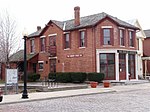American Osteopathic Board of Surgery
The American Osteopathic Board of Surgery (AOBS) is an organization that provides board certification to qualified Doctors of Osteopathic Medicine (D.O.) who specialize in the use of surgery to aid in the diagnosis and treatment of disease (surgeons). The board is one 18 medical specialty certifying boards of the American Osteopathic Association Bureau of Osteopathic Specialists approved by the American Osteopathic Association (AOA). As of 2011, 1,279 osteopathic physicians held active certification with the AOBS. The AOBS is one of two certifying boards for surgeons in the United States; the other certifying board is the American Board of Surgery of the American Board of Medical Specialties. Fellows of the AOBS are eligible for full membership in major U.S. surgical societies such as the American College of Surgeons (ACS) and the Society of Thoracic Surgeons. Board certified surgeons of the AOBS are also eligible for membership in the American Society for Metabolic & Bariatric Surgery.
Excerpt from the Wikipedia article American Osteopathic Board of Surgery (License: CC BY-SA 3.0, Authors).American Osteopathic Board of Surgery
Fishburg Road, Dayton
Geographical coordinates (GPS) Address Phone number Website Nearby Places Show on map
Geographical coordinates (GPS)
| Latitude | Longitude |
|---|---|
| N 39.8408 ° | E -84.1379 ° |
Address
Mikes Cycle&Skate
Fishburg Road 4782
45424 Dayton
Ohio, United States
Open on Google Maps






